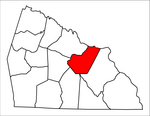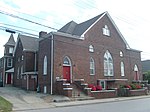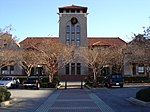Grimes Mill (Salisbury, North Carolina)
1896 establishments in North CarolinaBuildings and structures in Salisbury, North CarolinaBurned buildings and structures in the United StatesDefunct museums in North CarolinaDemolished but still listed on the National Register of Historic Places ... and 8 more
Flour mills in the United StatesGrinding mills on the National Register of Historic Places in North CarolinaIndustrial buildings completed in 1896Industry museums in North CarolinaMill museums in North CarolinaMuseums in Rowan County, North CarolinaNational Register of Historic Places in Rowan County, North CarolinaSecond Empire architecture in North Carolina

Grimes Mill was located at 600 N. Church St. in Salisbury, North Carolina. It was built in 1896 as a flour and feed mill. It stayed active until 1982. The Historic Salisbury Foundation bought it that year and later turned it into a museum. It was listed on the National Register of Historic Places and was the only roller mill museum in North Carolina. The site was destroyed by fire on January 16, 2013.
Excerpt from the Wikipedia article Grimes Mill (Salisbury, North Carolina) (License: CC BY-SA 3.0, Authors, Images).Grimes Mill (Salisbury, North Carolina)
West Franklin Street, Salisbury
Geographical coordinates (GPS) Address Nearby Places Show on map
Geographical coordinates (GPS)
| Latitude | Longitude |
|---|---|
| N 35.672777777778 ° | E -80.465555555556 ° |
Address
West Franklin Street 104
28144 Salisbury
North Carolina, United States
Open on Google Maps









